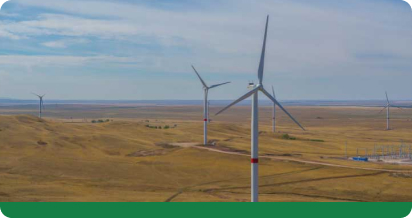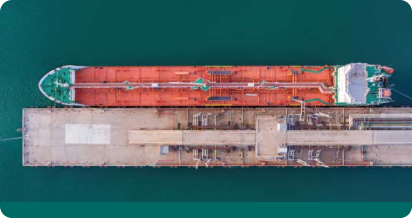According to the UN, for more than 40 % of the world population, the problem of water shortage is urgent and, according to forecasts, will worsen. Currently, more than 1.7 billion people live in river basins where water consumption exceeds the capacity to replenish water supplies.
According to the forecast of the World Resources Institute, Kazakhstan belongs to the countries with an average or high level of water scarcity (20-40 %), and by 2040 it will become one of the countries with an extremely high or high level of water scarcity. GRI 303-2, GRI 3-3
Since 2017, JSC NC KazMunayGas has implemented a Corporate Water Resources Management Standard, which defines 8 key “water” principles and establishes requirements for the activities of member organizations of the JSC NC KazMunayGas group in the field of water conservation and water consumption. The performance of the JSC NC KazMunayGas Group of companies in terms of the use of water resources are consolidated in the corporate center, where the total impact of the Company on water resources is analyzed. In addition, JSC NC KazMunayGas has been disclosing information about the water footprint as part of the Carbon Disclosure Project Water Safety Questionnaire since 2019.
In 2021, JSC NAC Kazatomprom approved the corporate standard “Guidelines for Monitoring of the Impact of Underground Borehole Leaching of Uranium on Subsoil Water and Groundwater”, and uranium mining enterprises have implemented and are monitoring groundwater. The goal of the standard is to establish uniform requirements for monitoring the state of natural waters in the area of the location of uranium deposits of JSC NAC Kazatomprom during the extraction of uranium by the method of underground borehole leaching and upon completion of this process by uranium mining enterprises.
To control the impact on water bodies, we monitor underground and surface water bodies on a quarterly basis. Observation monitoring wells are used for groundwater. We regularly reduce the volume of water taken and increase the recycling of water for surface water bodies. The results of monitoring the impact on sensitive water bodies are brought to the attention of stakeholders quarterly. Issues of water resources regulation in Portfolio Companies are coordinated by environmental departments. GRI 303-3
Water withdrawal
In 2022, the water withdrawal of Portfolio Companies of the Fund amounted to 304 143 Ml (thousand m3), which is 38.4 % more than the annual water intake of Astana. GRI 303-3
Our activities have the most significant impact on the water bodies of the western region of Kazakhstan (the Ural, Kigach, Kokzhide sands, Pyatimar reservoir); the Sharyn River and the Bestyubin reservoir (Moinak Hydroelectric Power Plant), the Syrdarya River and the Shardara reservoir, the K. Satpayev Canal, the Shiderty Canal (Big Almaty Lake and the basin of the Bolshaya Almatinka River (Cascade of hydroelectric power plants), the Kapshagai reservoir (Kapshagai hydroelectric power plant), the Shu-Sary basin, which represent a special ecological, economic, historical, cultural and recreational value. GRI 303-1
In 2022, the Fund companies took 205 073 Ml (thousand m3) of fresh water, which is 67.4 % of the total water withdrawal. The water withdrawal of salt water is 99 070 Ml (thousand m3), 32.3 % of the total water withdrawal of the Fund.
In 2022, 83 707 Ml (thousand m3) were taken for the purposes of oil and gas production and refining, which is 0.8 % less than the level of 2021 (thousand m3).
The total volume of water withdrawal in the uranium mining and processing sector amounted to 9 188.9 Ml (thousand m3), which does not exceed 3 % in the total volume of water withdrawal of Portfolio Companies of the Fund.
The main volume of water withdrawal is provided by underground water bodies (93.3 %).
In 2022, the heat and power generation sector withdrew 211 247 Ml (thousand m3), which is 133 Ml less than the volume of water withdrawal in 2021.
Water consumption
The Fund is a large-scale consumer of water resources. The total volume of water consumption in 2022 amounted to 304 143 Ml (thousand m3). GRI 303-5
The most significant sectors – consumers of water resources in the technological processes of the Fund are: electricity production (58.8 % of the total water consumption of the Fund; Samruk-Energy JSC), oil and gas production and processing (17.1 %; JSC NC KazMunayGas), thermal energy production (18.6 %; Samruk-Energy JSC), uranium mining and processing (does not exceed 2.8 %; JSC NAC Kazatomprom). For the purposes of this report, the water consumption of other sectors of the Fund Group is insignificant (2.7 %), as well as the consumption of water resources for household purposes. GRI 303-5
In 2022, 211 247 Ml (thousand m3) of water was consumed for the production of heat and electricity, which is 69.5 % of the total water consumption of the Fund. The water consumption of the heat and electricity production sector decreased by 133 Ml (thousand m3) as compared to 2021.
In 2022, water consumption by Portfolio Companies in the oil and gas production and refining sector amounted to 83 707 Ml (thousand m3), which is 27.5 % of the total water consumption of the Fund.
In 2022, the uranium mining and processing sector consumed 9 188.9 Ml (thousand m3), which is 9.2 % less than in 2021. The decrease in water consumption is related to the increase in uranium production in 2022.
Water discharge
In 2022, 87 926 Ml (thousand m3) were allocated, which is 1.1 % less than in 2021. Of this volume, 83 569 Ml (thousand m3) was discharge into artificial surface objects (filtration fields, storage pond, evaporation pond, etc.), 941 Ml (thousand m3) was transferred to third-party organizations. Water is discharged into evaporation ponds; the Fund does not discharge contaminated wastewater into water bodies. Standards of the quality of the diverted water, established by environmental legislation, are achieved using mechanical and biological methods of wastewater treatment. GRI 303-4
The most significant sources of industrial wastewater generation in the heat and electricity generation sector are the processes of removal and transportation of ash and slag waste to the ash dump through hydraulic ash handling systems, where wastewater is used as an additional transport agent. In 2022, the volume of wastewater discharged amounted to 73 818 Ml (thousand m3), which is 774 Ml (thousand m3) and 1 % less than in 2021.
The sector of oil and gas production and processing allocated 10 692.3 Ml (thousand m3) of wastewater. A significant amount of treated wastewater is reused only in the oil and gas refining sector, where 5 522.5 Ml was reused in 2022 (6.6 % of the total water consumption of Portfolio Companies in the oil and gas production and refining sector; thousand m3) of water, which is more by 502.2 Ml (thousand m3) than in 2021.
The uranium mining and processing sector allocated 3 415.6 Ml (thousand m3) in 2022, which is 29.2 % less than in 2021.
In 2022, the total volume of produced water amounted to 136 519.2 Ml (thousand m3), 99.2 % of which was reinjected for maintaining reservoir pressure. Additionally, small amounts of water are used to feed fire extinguishing systems, steam generation and household and drinking needs.
The Fund does not return water to natural water bodies. We are focused on the efficient use of water resources, and, as a result, on reducing water withdrawal. For the transparency of this indicator and the possibility of tracking it in the future, we understand that the water withdrawal indicator is equal to water consumption.
Further growth areas
Water resources management issues are one of the key climate risks for us. In this regard, we have developed an Energy and Resource Conservation Program for 2022–2027, the purpose of which is, among other things, the rational use of water resources. The analysis of Portfolio Companies’ data showed a low level of quality of the data obtained by calculation, and not by direct measurements. Therefore, our short-term task is to organize effective technical accounting of energy and water consumption, including automation of data collection and control over water use.
In 2023, it is planned to develop Water Resources Management Programs in JSC NC KazMunayGas and JSC NAC Kazatomprom, the goal of which is to conduct a detailed analysis and identify measures and target indicators to reduce water withdrawal, increase circulating water supply.
In order to find additional opportunities to reduce the loss of water resources, it is also planned to involve personnel in the rational consumption of energy and water resources. GRI 3-3, GRI 303-1
One of the main environmental measures is the implementation of the TAZALYQ project, within the framework of which the modernization and reconstruction of the mechanical and biological treatment facilities of Atyrau Refinery, as well as the reconstruction of evaporation fields and the channel of normatively treated effluents are carried out.
The desalination plant was commissioned at Karazhanbasmunai JSC in Mangystau region. The plant is designed for processing and utilization of reservoir water and supply of process water in order to increase oil recovery of the Karazhanbas field by steam injection into the reservoir.
Karabatan Utility Solutions LLP produces chemically purified water on the principle of zero liquid discharges for production facilities located in the territory of the National Industrial Petrochemical Technopark in Atyrau Region special economic zone (SEZ). The company provides water treatment and purification of all types of wastewater from technological lines to provide production water, fire water, demineralized water, desalinated water for the technological needs of the Infrastructure of the Integrated Gas Chemical Complex (KPI LLP) and KUS LLP, as well as for the future needs of KLPE LLP, Butadiene LLP.
This process makes it possible to eliminate the discharge of liquid waste into the environment, create a closed water cycle, thereby significantly reducing the need for source river water as a raw material for obtaining desalinated water for the needs of enterprises, and increase the efficiency of the feedstock.



